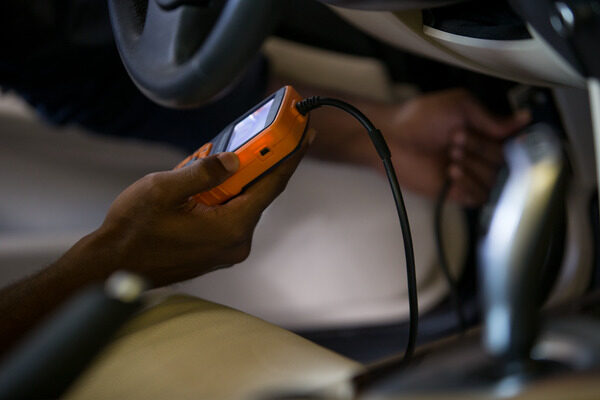
You probably know that your car has a serpentine belt, but do you know what it does? The serpentine belt transfers power from the crankshaft to many components in your car’s engine. It’s important to know how it works and the symptoms of a bad serpentine belt so you can keep your car running more smoothly and efficiently. [1]
What does a serpentine belt do?
The serpentine belt wraps around various pulleys inside the engine to help transfer power from the crankshaft to different accessories such as the alternator, power steering pump, air conditioner, and possibly the water pump in the cooling system. [2]
Serpentine belt vs. timing belt
In your car, the serpentine belt and the timing belt have different functions. The serpentine belt helps the engine parts run smoothly.
The timing belt is located inside the car’s engine and keeps the crankshaft and camshaft synchronized. Keeping them in sync allows the intake and exhaust valves to operate properly, and in turn keeps the engine running smoothly.
Look closely at the grooves on the belts to tell the difference between them. The serpentine belt has V-shaped grooves that run vertically, while the timing belt has horizontal grooves fit to the cogwheels of the crankshaft and camshaft. [3]
How long does a serpentine belt last?
The good news is that your serpentine belt typically doesn’t need to be changed often. It’s recommended to get it checked and possibly replaced every 60,000 to 100,000 miles. Check your owner’s manual if you want a more specific recommendation for your car. [1]
Risks of driving with a broken serpentine belt
While it’s possible to drive on a snapped serpentine belt, it’s very dangerous and not recommended that you do so. It can make steering the car very difficult if not impossible. Take or tow your car to a professional and have them replace it as soon as possible. [4]
Identify these bad serpentine belt symptoms
To catch a bad serpentine belt as soon as possible and avoid further damage, look out for these signs:
- High-pitched noises: When your belt is misaligned, it will emit a squeal from under the hood.
- Problems with your A/C: When the belt gives out, the A/C system becomes nonfunctional.
- Overheating engine: Your belt can stop the water part from functioning, which supplies coolant to the engine. When this happens, the engine can overheat.
- Check engine light: When your belt is on its last legs, the check-engine light can come on. [5]
What causes a serpentine belt to break?
Several factors can cause a serpentine belt to snap:
- An already weak belt: If your serpentine belt is older and made from neoprene rubber, it can break earlier.
- Oil leaks: If your belt is soaked with oil, it can break.
- Misaligned pulleys: If the pulleys aren’t aligned correctly, the belt can wear out faster than expected. [6]
Tools and tips to safely replace a serpentine belt
While it’s not that difficult to replace your own serpentine belt, if you aren’t sure how to do it yourself, it’s recommended to take your car to a professional. If you have the tools and knowledge to do it yourself, here are the steps you should take:
- Check the placement of the serpentine belt in your engine.
- Examine the tension of the worn serpentine belt.
- Remove the belt by loosening it and unthreading it.
- Check the old belt for any damage.
- Ensure that every pulley is aligned correctly.
- Install the belt by using a belt replacement tool.
Serpentine belt replacement cost
A professional mechanic can typically charge between $75 and $120 to replace your serpentine belt. Keep in mind that the cost of a serpentine belt depends on the current inflation rate as well as your location. Always get an estimate from your mechanic on costs associated with your car parts. [2]
Replacing your serpentine belt when needed isn’t the only important maintenance task to perform on your car. Use this maintenance checklist to keep up with the various time-sensitive checks and changes that your vehicle needs to run at its best. Lastly, make sure you have the proper auto insurance to cover yourself and your car.
Sources:
[1] “ What Is A Serpentine Belt?” jdpower.com/cars/shopping-guides/what-is-a-serpentine-belt (accessed Dec. 20, 2023).
[2] “How To Replace Your Serpentine Belt,” autozone.com/diy/belts/how-to-replace-a-serpentine-belt (accessed Oct. 10, 2023).
[3] “What Is a Serpentine Belt & When Should You Replace It?” vatire.com/car-maintenance-tips/everything-you-need-to-know-about-serpentine-belts (July 13, 2020).
[4] “5 Symptoms of a Bad Serpentine Belt (and Replacement Cost),” Mark Stevens, cartreatments.com/symptoms-bad-serpentine-belt-replacement-cost (Jan. 6, 2021).
[5] “Signs of a Bad Serpentine Belt,” europeanautomotors.com/blog/signs-of-a-bad-serpentine-belt (Jan. 30, 2023).
[6] “What Causes a Serpentine Belt To Break? (Replacement Cost),” Bryan Matt, autocareaids.com/what-causes-a-serpentine-belt-to-break (Jan. 2, 2022).
[7] “Serpentine Belt Replacement: Step-By-Step Guide (+FAQs),” repairsmith.com/blog/serpentine-belt-replacement (accessed Oct. 10, 2023).
Disclaimer:
The information included here is designed for informational purposes only. It is not legal, tax, financial or any other sort of advice, nor is it a substitute for such advice. The information may not apply to your specific situation. We have tried to make sure the information is accurate, but it could be outdated or even inaccurate in parts. It is the reader’s responsibility to comply with any applicable local, state or federal regulations. Nationwide Mutual Insurance Company, its affiliates and their employees make no warranties about the information nor guarantee of results, and they assume no liability in connection with the information provided. Nationwide and the Nationwide N and Eagle are service marks of Nationwide Mutual Insurance Company. © 2024 Nationwide



